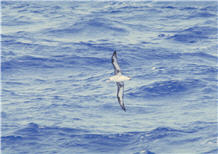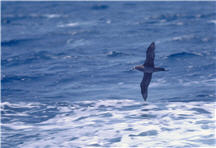 Laysan Albatross Phoebastria
immutabilis
Laysan Albatross Phoebastria
immutabilis
The Laysan is the most numerous of the three species of albatross breeding in the North Pacific (almost entirely on the northwestern Hawaiian Islands). But the bulk of the population forages in the northwest quadrant of the Pacific Ocean, making the species rare off California. In 1986 the Laysan Albatross established a new breeding colony just 210 miles south of San Diego of Guadalupe Island (Dunlap 1988). But the only certain records for San Diego County are of two birds found dead on beaches.
Migration: Linda Belluomini found a Laysan Albatross dead and partly decomposed on the beach just north of the Santa Margarita River mouth (G4) 31 March 1983 (SDNHM 42196). Charles Herzfeld found another at Torrey Pines City Beach (O7) 8 March 2000 (SDNHM 50396). The report of a Laysan Albatross found dead at the south end of Blair Valley (L24) 28 May 1982 is plausible, as there are eight well-supported records elsewhere in the Colorado Desert May–July, presumably of birds that wandered north out of the Gulf of California (Patten et al. 2003). But no remains of the albatross in Blair Valley were preserved (AB 36:893, 1982).
Conservation: Although the Laysan Albatross expanded its breeding range in the late 20th century by colonizing several islands in the eastern Pacific (Pitman 1988), its recent population trend has been downward. It faces two serious threats: death from swallowing the baited hooks trailed by longline fishing ships and death from swallowing bits of floating plastic trash, accumulating in massive quantities in the North Pacific gyres.
 Black-footed
Albatross
Phoebastria nigripes
Black-footed
Albatross
Phoebastria nigripes
The Black-footed was the only albatross regular on the ocean off San Diego during the 20th century. It was once fairly common during late spring and summer, but its numbers off southern California have decreased greatly. An unsustainably high rate of mortality due to incidental kill by the longline fishery now threatens the entire species.
Migration: Off southern California, the Black-footed Albatross is most frequent in May and June, concentrating along the Santa Rosa–Cortés Ridge (Briggs et al. 1987). It is rare closer to shore than San Clemente Island, though it has been seen as near the mainland as 1 mile off Mission Beach 16 May 1981 (G. McCaskie) and 3 miles off San Diego 20 May 1989 (J. O’Brien, AB 43:536, 1989). The only specimen preserved from shore was found dead on the beach at Carlsbad (I6) 27 May 1981 (SDNHM 41400).
Conservation: From the maximum of 112 birds 25 miles west of Point Loma 5 August 1958 (AFN 12:436, 1958), the number of Black-footed Albatrosses seen off San Diego County has declined steadily. In the 1970s three to six could be expected on a spring or summer day spent on a boat well offshore (Unitt 1984). Since then the species has become rare, in parallel with the decline of the ocean productivity off southern California during the warm-water years of the 1980s and 1990s. Across the North Pacific Ocean, the number of Black-footed Albatrosses killed by swallowing the baited hooks drawn behind longline fishing ships is greater than what the species’ reproductive rate can sustain. As a result, the International Union for the Conservation of Nature has designated the species as threatened.
Short-tailed Albatross Phoebastria albatrus
During the 19th century, before it was reduced to the verge of extinction by plume hunters at its nesting colonies in the western Pacific, the Short-tailed Albatross was common on the ocean off southern California year round. Gradual recovery began in the second half of the 20th century, and sporadic sightings off California—one far off San Diego—have increased in tandem. But the species remains of one of the world’s most endangered birds.
Migration: Anthony (1924) wrote, “a quarter of a century ago … ten miles from land they [both the Short-tailed and Black-footed Albatrosses] were almost certain to be found, and in the waters nearer land they were by no means uncommon… So far as my experience goes, there was no particular time of year when either species was more abundant.” Cooper (1868) reported collecting three immatures even inside San Diego Bay. The most recent specimen was taken off San Diego 9 January 1896 (SDNHM 68).
Conservation: From 1933 to 1950 the Short-tailed Albatross hovered on the brink of extinction. Protection and rehabilitation of its primary nesting site, the Japanese island of Torishima, has allowed the population to grow, reaching approximately 1500 birds in 2001 (http://www.fakr.noaa.gov/infobulletins/2001_infobulletins/albatrossbreeding.html). From 1898 to 1977 there were no well-supported records for California, but 11 accumulated from 1977 through 2002. The sightings closest to San Diego are of an immature 90 miles west of San Diego 28 August 1977 (Luther 1980) and another near Santa Barbara Island 19 February–22 March 2002 (Cole and McCaskie 2004). Although the population trend is now positive the species still faces threats: drowning of birds taking baited fish hooks from longline fishing boats and swallowing of floating plastic trash, blocking the birds’ digestive tracts.